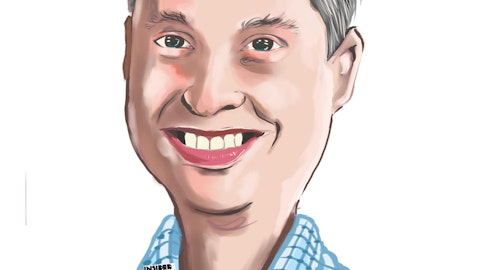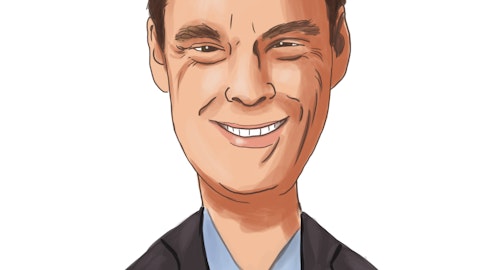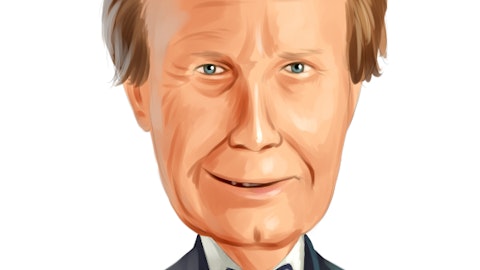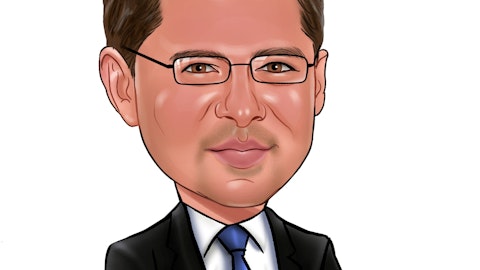Grosvenor Capital Management, L.P. (NASDAQ:GCMG) Q4 2022 Earnings Call Transcript February 14, 2023
Operator: Good day, and welcome to the GCM Grosvenor Fourth Quarter and Full Year 2022 Results Call. Later, we will conduct a question-and-answer session. As a reminder, this call will be recorded. I would now like to hand the call over to Stacie Selinger, Head of Investor Relations. You may begin.
Stacie Selinger: Thank you. Good morning, and welcome to GCM Grosvenor’s fourth quarter and full year 2022 earnings call. Today, I am joined by GCM Grosvenor’s Chairman and Chief Executive Officer, Michael Sacks; President, Jon Levin; and Chief Financial Officer, Pam Bentley. Before we discuss this quarter’s results, a reminder that all statements made on this call that do not relate to matters of historical fact should be considered forward-looking statements. This include statements regarding our current expectations for our business, our financial performance and projections. These statements are neither promises nor guarantees. They involve known and unknown risks, uncertainties and other important factors that may cause our actual results to differ materially from those indicated by the forward-looking statements on this call.
Please refer to the factors in the Risk Factors section of our 10-K, our other filings with the Securities and Exchange Commission and our earnings release, all of which are available on the Public Shareholders section of our website. We’ll also refer to non-GAAP measures that we view as important in assessing the performance of our business. A reconciliation of non-GAAP metrics to the nearest GAAP metric can be found in our earnings presentation and earnings supplement, both of which are available on the Public Shareholders section of our website. Our goal is to continually improve how we communicate with and engage with our shareholders. And in that spirit, we look forward to your feedback. Thank you again for joining us. And with that, I’ll turn the call over to Michael.
Michael Sacks: Thank you, Stacie. During the fourth quarter of 2022, our financial results were in line with or moderately exceeded the expectations that we communicated on our last earnings call. Despite a challenging backdrop, we performed well for clients while raising $1.5 billion of capital to achieve total funds raised of $7.8 billion for the year. Our private markets verticals continued to grow with Q4 private markets management fees, excluding catch-up fees rising by 10% over the fourth quarter of 2021 and 14% for the full year 2022. Fee-related earnings for the full year increased by 7%, while FRE margin improved by 100 basis points. As was the case for the entire category, adjusted EBITDA and net income were lower than the prior year due to the capital markets environment.
On a bright note, during the quarter, we were pleased to launch a new and important specialized fund Elevate with a $500 million anchor investment. As with our investment in Grosvenor Insurance Solutions, we believe that the Elevate strategy, part of a broader Sponsor Solutions category provides the firm with a lot of promise, and Jon will take you through that in his remarks. Looking ahead, the continued growth of our private markets management fees, combined with our strong fundraising pipeline, including our five private markets specialized funds in market leave us confident that we can compound fee-related earnings in 2023 and beyond at mid-teens rates. While forecasting incentive fees is always a challenge, the earnings power represented by our absolute strategies performance fees combined with our significant carry asset, give us confidence that we have similar strong rates of growth in adjusted EBITDA and adjusted net income over time.
For 2023, we can achieve these objectives with lower levels of total fundraising than we saw in 2022. That said, like last year, we believe total fundraising in ’23 will be weighted towards the back of the year and will exceed or equal 2022 levels. Overall, we expect full year 2023 growth in private markets management fees in the mid to high teens over 2022. For Q1 ’23, we expect continued strong private market management fee growth, excluding catch-up fees of 11% to 13% over Q1 of ’22, with overall private markets management fee growth, a couple of points below that due to minimal expected fund closings in the quarter. Due to the back-end weighting of our fundraising, the limited Q1 catch-up fees, the full effect of the 22 absolute return strategies results and the timing of certain compensation-related expenses, we expect Q1 fee-related revenue and fee-related earnings that are both slightly lower than Q4 of ’22.
This month marks the two year anniversary of our first earnings call as a public company, and it is worth reflecting on our performance over that period of time. Since coming public, we have raised $17 billion of new capital, of which $9 billion was in fee accretive strategies such as co-investments, secondaries and direct investments. With more than $10 billion of dry powder across strategies as of year-end, our fundraising success leaves us enthusiastic about our ability to capture investment opportunities and generate alpha for clients. During the last two years, we have grown both private markets fee-paying AUM and management fees by 32% with private market strategies now comprising 63% of our fee-paying AUM, up from 54% just two years ago.
We believe that this double mix shift, the movement towards more private markets AUM and more fee accretive strategies will continue to be a driving force of value creation going forward. In addition to the growth we have achieved, we have made strategic investments in our business to capture white space and lay the groundwork for continued growth in the coming years. Our offices in Toronto and Frankfurt are new efforts in insurance solutions, where we’ve already seen results and our new Sponsors Solution efforts all provide significant opportunity. Our fee-related earnings margin increased from 31% two years ago to 36% at year-end as we realize the scalability and operating leverage embedded in our business. We believe we have continued room to expand in that regard.

Photo by Bench Accounting on Unsplash
Our existing clients are re-upping at higher rates and in greater amounts, and we are growing our specialized fund franchises with successor funds achieving larger size and scale than their predecessors, all while bringing new funds to market. Finally, we have made good on our commitment to return significant excess cash to our shareholders. Since going public just two years ago, we have paid $0.74 in cumulative dividends per share, increasing our quarterly dividend four times from $0.06 to $0.11 per share. As of Friday, our annualized quarterly dividend was 4.7%. In addition, we’ve returned $44 million of capital through share and warrant repurchases. We have managed our share count, and as Pam will describe, we intend to significantly mitigate any dilution associated with our LTIP and stock-based compensation going forward.
In closing, despite last year’s tough environment, we are proud of our results both last year and over our first two years as a public company. We delivered value for our clients despite a powerful paradigm shift, significant market losses and record-setting volatility. The value proposition for clients and the strength of our business model have shown well while the opportunities for clients and shareholders in ’23 and beyond are as compelling as they have ever been. Importantly, investor demand for alternatives remains strong. We continue to believe that our stock represents good value, and we look forward to delivering for all of our stakeholders going forward. And with that, I will turn it over to Jon.
Jonathan Levin: Thank you, Michael. Our $7.8 billion of fundraising in 2022 was once again noteworthy for its high level of diversification across strategy, client and geography. Private markets, which now represents 69% of total AUM represented 93% of fundraising in 2022 and was diversified across each of private equity, infrastructure and real estate. This year, 56% of private market capital raised within fee-accretive strategies such as co-investments, secondaries and direct investments. Notably, we reached the final close of our secondaries opportunities fund, GSF III, which at $972 million was 38% larger than its predecessor fund. As with past years, our existing clients were a key driver of capital formation, contributing 85% of new commitments in 2022.
Our clients’ validation of our value proposition, especially against the difficult market is not only rewarding but a strategic advantage as investors currently have a high bar for where they commit their capital. Importantly, many of these new commitments were to new programs or new strategies as clients expanded the scope of their relationship with GCM Grosvenor into new areas. Our ability to evolve and expand with our clients has been and will continue to be one of the strongest drivers of our future growth. A perfect illustration of this phenomenon was the launch of our new Sponsored Solution strategy in the fourth quarter. The first initiative in this category is our Elevate strategy, which will focus largely on seeding small, emerging and diverse private equity managers and which was launched with a $500 million investment from the California Public Employees Retirement System.
Calpers has been a GCM Grosvenor client for over a decade, and we’re very excited to be expanding our long-standing relationship with their team with the new Elevate strategy. The Sponsor Solutions category is also a fantastic example of the extension possibilities of our platform and our ability to build on our existing strengths. Our expertise investing in small, emerging and diverse managers is already a key differentiator for the firm. We have invested in small and emerging managers for 30 years, culminating in nearly $18 billion of assets under management as of year-end and have had a dedicated effort investing in diverse managers for the past 20 years with more than $13 billion in assets under management. We have consistently believed that there is a significant too frequently overlooked opportunity to generate exceptional risk-adjusted returns by investing in small, emerging and diverse managers.
And as you’ll see in our public disclosures, our track record and diverse managers exceeds that and private equity investors more broadly. As a result of our long-standing leadership, we have built a fantastic network of relationships and a reputation as a preeminent source of capital for any new investor looking to launch a fund. The Elevate strategy is a natural extension of these efforts. We are leveraging our existing expertise in partnering with successful firm founders early in their life cycles to make catalytic seed investments structured as minority investment partnerships that enable managers to scale successfully while generating compelling returns for our investors. This product is also an example of extending into adjacencies that enable us to leverage the existing platform resources to a large degree.
The Sponsor Solutions category will be led by a new senior partner and one of our existing senior partners who is moving roles Last quarter, I discussed the significant value inherent in our customized separate account relationships, which were 74% of assets under management as of year-end. We are constantly in dialogue around new potential customized separate accounts, which represent 78% of capital raised in 2022 and will continue to be an essential growth driver going forward. While we do not anticipate meaningful specialized fund closings in the first quarter, we expect specialized funds to have a greater impact to our 2023 fundraising and results as the year moves on. With that, I’ll turn the call over to Pam.
Pamela Bentley: Thanks, Jon. The strength and scalability of the GCM Grosvenor platform were evident in our ’22 results and remain the key factors driving our growth in ’23 and beyond. In the fourth quarter, private markets was again our primary area of growth with private market fee-paying AUM, up 11% from a year ago. Excluding the impact of catch-up fees, which were $1.6 million in the quarter, private markets management fees increased 10% from the fourth quarter of ’21. For the full year ’22, private markets management fees increased 12%. And while we are satisfied with this growth, given the challenging market backdrop, we expect to exceed that growth rate in ’23. For Q1 ’23, we expect continued strong private market management fee growth, excluding catch-up fees of 11% to 13% over Q1 ’22.
As we foreshadowed on our last call, absolute return strategies management fees declined 0.5% this quarter as compared to the third quarter of ’22. Given the ’22 starting point of ARS fee-paying AUM, we expect ARS management fees in Q1 ’23 to be slightly down on a sequential quarter basis. We realized $7.2 million of incentive fees in the quarter, the majority from carried interest. While we cannot predict the timing of when a more active transactional environment will resume, our carried interest earnings power continues to improve. As of year-end, we have $789 million in gross unrealized carried interest across 131 programs, the firm share of which is $368 million. Despite the market environment, this figure is 11% higher than a year ago, given the outperformance of our private market portfolios versus the public markets.
Our annual performance fees are tied to ARS investment returns and typically crystallize in the fourth quarter each year. Given ’22 public market impacts and the high watermarks of our ARS funds, our ’23 performance fee earnings potential, assuming an 8% growth rate of return for multi-strategy and a 10% growth rate of return for opportunistic investments is approximately $17 million, which compares to $30 million if all portfolios were at high watermark. Turning to expenses. Fee-related earnings compensation in the quarter was approximately $38 million, down slightly compared to the third quarter as we finalize year-end results and made our discretionary compensation decisions. Consequently, we expect fee-related earnings compensation in the first quarter of ’23 to generally be consistent with the first quarter of ’22.
Other than strategic investments in the business, we do not expect significant headcount growth over the coming year. We continue to focus on alignment of our team’s compensation with the performance of the business through the use of stock awards to both reward and retain our talent. As we have said before, this tool was one of the factors that made coming public attractive. We have two basic prongs to our approach to stock-based awards. First, we want to continue to use our LTIP to align and incentivize our employees, and we grant restricted stock with varying vesting periods to provide both current reward and long-term retention. In ’22, we granted 4.5 million restricted shares to employees. Second, we have and will continue to buy back shares to offset dilution from stock-based compensation.
As of year-end, we had more than $45 million remaining on our stock buyback authorization. Non-GAAP general and administrative and other expenses were approximately $19 million in the fourth quarter, up modestly from the third quarter. We expect a slight sequential increase in this figure in the first quarter of ’23 and continue to tightly manage expenses despite inflationary pressures. Our fee-related earnings margin expanded to 36% in ’22 from 35% in ’21. We anticipate continued long-term fee-related earnings margin expansion in ’23 and beyond. To reiterate, we anticipate private markets management fees will grow in the mid to high teens in ’23, resulting in fee-related earnings growth in the mid-teens. While we are not immune to the impact of the current market environment, our track record of strong performance, the scale and diversification of our platform, combined with the strength of our team and culture, provide us with great confidence.
We remain focused on delivering long-term value to our clients and shareholders. Thank you again for joining us, and we’re now happy to take your questions.
See also 13 Most Undervalued REIT Stocks to Buy and 16 Most Valuable Japanese Companies.
Q&A Session
Follow Gcm Grosvenor Inc.
Follow Gcm Grosvenor Inc.
Operator: Thank you. And our first question will come from Chris Kotowski with Oppenheimer.
Chris Kotowski: Yeah. Good morning and thanks for taking my questions. I wanted to start on the Elevate program. And first, I was wondering, has there been any precedent in your experience where you – obviously, not on the scale, but where you had an anchor tenant of this nature come in with a big commitment. And is there any way to think about how the ultimate fund resulted – that resulted compared to the initial commitment?
Michael Sacks: Sure. So the short answer is we have had large anchors that have helped to launch funds in the past. And all of our specialized funds that we’ve launched have turned into – I don’t know if the right word, franchises, if you will, Chris, and have then gone on to successor Fund II and successor Fund III, et cetera. So we are incredibly excited about Elevate, and we’re excited about it on a few different levels. One, to start with an anchor of that size and that quality and caliber is a terrific thing, and we think it will get attention in the marketplace and it will enable us to have this first one, be larger in terms of its size than simply the anchor investor. We’re not putting a number on that. We don’t do that, but we do – and Jon did mention in his remarks, we will be raising money for this fund for the next 18 to 24 months.
Second, we think the fund itself is a fantastically exciting fund that is addressing a real need in the market, which is seed capital and all kinds of other support for new small emerging and diverse managers to launch private equity firms. And we think that there are – there’s ample opportunity for us to deploy the capital there to generate very good returns on that capital. And on behalf of our investors in Elevate to own interest in new private equity sponsors that will grow and turn into terrific valuable businesses. And as you know, we have been in the business of allocating capital to early stage Fund I private equity managers and the small emerging and diverse manager space for a long, long time, decades. And so we feel very confident in our ability to deploy the capital wisely, and we know that the returns available to the capital when you get that right or outsized.
So we’re very excited about it. And the last point I would just want to reiterate on Elevate, which Jon touched on and tried to talk about in his comments is that it is a Sponsor Solution program where we are delivering value to sponsors. And we believe that there are other ways that we can deliver value to sponsors over time and other opportunities, and we’re excited about building out Sponsor Solutions broadly defined as we move forward into the future. So it was a terrific, very bright spot in the fourth quarter, and we’re thrilled to have that fund in market this year, which is not something that we had communicated about prior, and we think it’s a very positive development for the firm and for our future.
Chris Kotowski: Yes. And you said you’d be fundraising for 18 months or so. Presumably, it turns on before that time. But financially speaking, it’s probably not an event for 2023 numbers. Am I thinking about that correctly…
Michael Sacks: No. That – the fees for that fund have turned on already on January 1. So we will enjoy some revenue from that fund from the anchor investor in 2023 and the structure of that fund is it’s a fees on committed capital with a catch-up. So as we raise money for that fund, those fees will go back to January 1.
Chris Kotowski: Okay. That’s it for me. Thank you.





